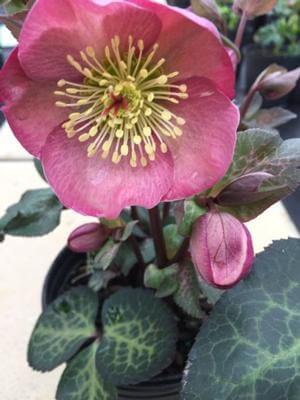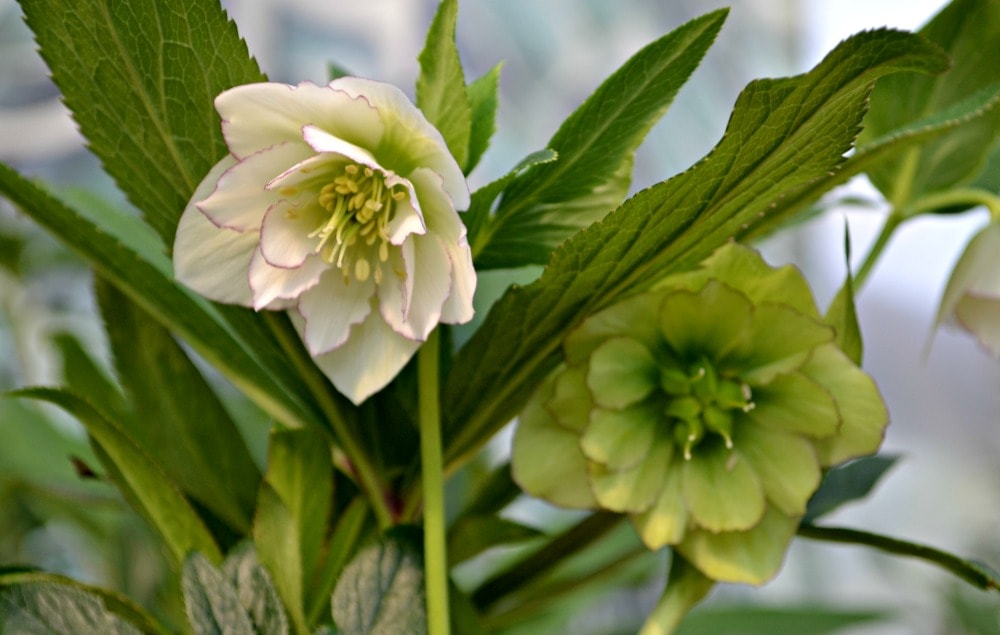Hellebores: Tough, Evergreen, Winter-Blooming Perennial
As winter inches ever-closer, the perennial department turns its attention to the hero of the winter shade garden: the hellebore.
Helleborus, also known as Lenten Rose or Christmas Rose, due to the fact they are often blooming during Lent, are beloved for their elegant, cup-shaped, nodding blooms and tough, evergreen foliage. Hellebores are typically hardy in zones 5 through 9 and prefer partial shade to full shade (but like to be in an area where they get a bit more sun in winter – under a deciduous tree, perhaps.)
One of the most desirable traits is the bloom time. It is one of the earliest bloomers, with a typical blooming window from January to April, depending on the variety. Some varieties can even begin blooming in the fall (as early as September) and last up to seven months, i.e. the Winterbells variety from the JWLS series.

As for caring for your hellebores, they are delightfully low maintenance. Hellebores like humus-rich, well-draining soil, and once established, are extremely drought tolerant! Getting them established simply requires consistent watering, while allowing them to dry out a bit between watering. The most common way to kill a hellebore is with too much water. So when in doubt, err on the dry side. They’re also one of a very few perennials that do exceptionally well in a container!
While most hellebores have the same bloom time and light requirements, certain varieties have been bred to bloom earlier or tolerate more sun. The Ice N’ Roses Series, for example, can handle more sun than other varieties, though in our area the foliage can get a little sunburned in the peak summer months. Hellebores niger, or Christmas Rose, blooms closer to Christmas than Lent. One beautiful example being the ‘Winter Star’ variety which has dark green foliage and bright white flowers with yellow centers. The majority of varieties on the market now are bred to be sterile, so you don’t have to worry about self-sowing plants taking over your garden. However, if that is something you desire, old varieties of Helleborus orientalis, like ‘Pine Knot Select’ have fertile seeds and will self-sow, growing your collection.
Hellebores have three different blossom forms: single bloom, double bloom, and anemone form. Single bloom is the standard, most commonly occurring form (example: Helleborus Ice n’ Roses ‘Mona Marble’). Double blooms are fluffy and showy (example: Helleborus orientalis ‘Double Spring Ruby’), and anemone-form blooms are a cross between the two with an outer row of large petals and an inner row of short, tight petals. (example: Helleborus ‘Tutu’).

Like most plants, Hellebores appreciate a good tidying up. The best time to prune is in late winter or early spring when new growth begins to appear on your plant. Cut away tattered, old growth as close to the base as possible and your grateful plant will put all its energy into producing fresh new foliage for you.
All parts of the Hellebore are highly toxic, and it has a fascinating, but sordid history of being used as a poison – long ago. But don’t let that frighten you off! For those of us with overly voracious deer and bunnies in our yards, the toxicity (and taste – so I’m told) make it a plant rarely nibbled by animals. And thankfully, animals typically find the taste unpleasant enough to prevent them from eating amounts to make them seriously ill.
This unusual, but elegant plant is a must-have for those looking for winter interest! Get it in the ground (or pot) and admire the effortless beauty.




